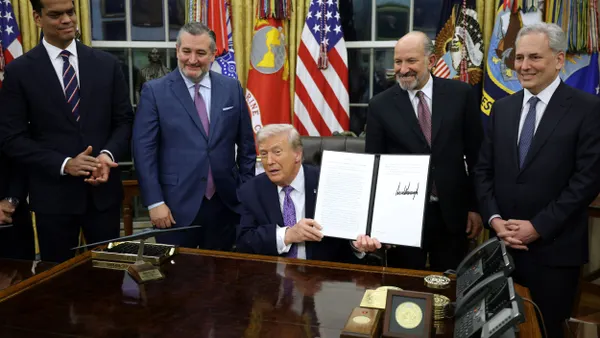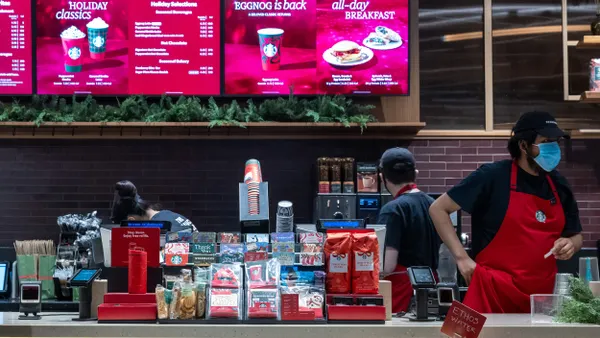Dive Brief:
- The Federal Reserve's emergency Sunday evening measures did little to reassure markets as U.S. stock futures plunged and European and Asian stock indexes dropped Monday morning.
- In an emergency move reminiscent of the type of actions it took during the 2008 global financial crisis, the Fed cut its short-term target rate by 100 basis points, bringing its benchmark rate to essentially zero.
- It also indicated it was prepared to buy $700 billion in Treasuries and mortgage-backed securities, cut the rate charged to banks for short-term emergency loans from its discount window and activate swap lines with five other central banks, The Wall Street Journal reported.
Dive Insight:
“The Committee decided to lower the target range for the federal funds rate to 0% to 0.25%,” the Fed said in its announcement of the rate move. “The Committee expects to maintain this target range until it is confident that the economy has weathered recent events and is on track to achieve its maximum employment and price stability goals.”
In response, the Dow Jones stock futures index dropped almost 5% — the most it can drop before off-hours trading is stopped — and investors poured money into the U.S. Treasuries, pushing down yields to 0.759% from 0.946% on Friday. Later in the morning trading had to be halted, for the third time in two weeks, because of the scale of the drop.
Stocks were down in Europe and Asia, too. At the start of trading this morning, the Stoxx 600 was down 8% and the Australian stock index was down nearly 10%.
Particularly hard hit were bank stocks, especially in Europe: Barclays, Crédit Agricole, UniCredit, Société Générale, ING Groep, Credit Suisse Group and BNP Paribas dropped by more than 10%, The Journal reported.
The Financial Services Forum, a trade group representing the largest banks in the U.S., earlier issued a statement that banks are in good shape from a capital standpoint to combat the economic uncertainty in the months ahead.
“The nation’s largest banks remain strongly capitalized, resilient, and fully capable of fulfilling their important role in the economy, even under times of stress,” it said.
Dramatic actions
The Fed’s weekend move follows previous steps it’s taken in response to the virus outbreak, including a half-point cut in its target rate on March 6 and an injection of $150 billion into capital markets on Friday.
Analysts say the Fed move has failed to shore up confidence because it’s seen as an act of desperation, on the one hand, and a misplaced policy initiative, on the other, because the government action that’s needed the most right now is on the fiscal side, not the monetary side.
“The onus is on the government to implement fiscal measures in order to stem the economic damage from the coronavirus outbreak," Adam Vettese, an analyst at investment platform eToro, said in a note.
"Legislators should be doing fiscal stimulus," Mayra Rodriguez Valladares, a capital market consultant who works with banks, told Banking Dive. "The market is collapsing not because bankers and traders can’t cope with risk; these people deal with risk every day. The reason that there's such a freakout is because of the uncertainty. … The Fed can only do so much."
Legislation in works
There is fiscal action on the horizon. The House last week passed legislation that responds to the outbreak by giving workers two weeks of paid sick leave and up to three months of paid family leave. It also helps set the stage for expanding virus testing by allowing the costs of tests to be covered by insurance and federal programs. There are also provisions to make emergency food assistance more widely available and that add to unemployment insurance benefits.
The bill could be taken up in the Senate this week and President Trump has signaled his support, but whether the legislation is up to the challenge presented by the outbreak remains to be seen. Critics say there are too many exceptions and limits to the sick-leave assistance to match the need, among other shortcomings.
“The bill guarantees sick leave only to about 20 percent of workers,” The New York Times wrote in an editorial. “Big employers like McDonald’s and Amazon are not required to provide any paid sick leave, while companies with fewer than 50 employees can seek hardship exemptions.”
Despite the Administration’s support, passage in the Senate isn’t a certainty, in part because of concerns with the sick-leave requirements on employers. We “will need to carefully review the version just passed by the House,” Sen. Mitch McConnell, the majority leader, has said.
The bill follows an emergency spending measure enacted March 6 that will pump $8.3 billion into federal health agencies to help them deal with the crisis.













